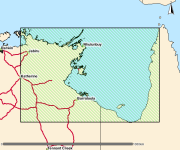Type of resources
Topics
Keywords
Contact for the resource
Provided by
Years
-
The Tasman Fracture CMR AUV survey was a pilot study undertaken in 2014/15 as part of the National Marine Biodiversity Hub's National monitoring, evaluation and reporting theme. The aim of this theme is to develop a bluepint for the sustained monitoring of the South-east Commonwealth Marine Reserve Network. The particular aim of the survey was to contribute to an inventory of the distribution and abundance of demersal fishes in the reserve and adjacent reference sites using BRUVs. Data contained here represents footage collected using these drops and the associated scored data (abundance and lengths).
-
Phytoplankton productivity in the polar Southern Ocean (SO) plays an important role in the transfer of carbon from the atmosphere to the ocean’s interior, a process called the biological carbon pump, which helps regulate global climate. SO productivity in turn is limited by low iron, light, and temperature, which restrict the ef- ficiency of the carbon pump. Iron and light can colimit productivity due to the high iron content of the photosynthetic photosystems and the need for increased photosystems for low-light acclimation in many phytoplankton. Here we show that SO phytoplankton have evolved critical adaptations to enhance photosynthetic rates under the joint constraints of low iron, light, and temperature. Under growth-limiting iron and light levels, three SO species had up to sixfold higher photosynthetic rates per photosystem II and similar or higher rates per mol of photosynthetic iron than tem- perate species, despite their lower growth temperature (3 vs. 18 °C) and light intensity (30 vs. 40 μmol quanta·m2·s−1), which should have decreased photosynthetic rates. These unexpectedly high rates in the SO species are partly explained by their unusually large photosynthetic antennae, which are among the largest ever recorded in marine phytoplankton. Large antennae are disadvan- tageous at low light intensities because they increase excitation energy loss as heat, but this loss may be mitigated by the low SO temperatures. Such adaptations point to higher SO production rates than environmental conditions should otherwise permit, with implications for regional ecology and biogeochemistry.
-

Parks Australia - Our Marine Parks Grants Round 2 Project: Nearshore marine habitat mapping of the Norfolk Marine Park (Grant Activity ID: 4-FIZ391E) The Norfolk Marine Park is the is the eastern-most Park in the Temperate East Network of Australian Marine Parks, located between the NSW coast and Norfolk Island. The Park encompasses 188,444 km² of ocean and ranges in depth from 0 m at the Norfolk Island high tide mark to more than 5,00 m off the edge of the Norfolk Ridge. The Park includes two key ecological features – the Norfolk Ridge, and the Tasman Front and associated eddy field – both of which are valued for their high productivity, aggregations of marine life, biodiversity, and endemism. Norfolk Marine Park supports a range of species, including those listed as threatened under the Environment Protection and Biodiversity Conservation (EPBC) Act (1999), and contains Biologically Important Areas for breeding, foraging, and migration of seabirds, marine turtles, and humpback whales. The objective of this project was to create the first marine habitat map for the nearshore shallow water surrounding Norfolk, Nepean, and Phillip Islands. This was conducted in collaboration with Norfolk residents to provide local knowledge input and to ground-truth the remotely-sensed habitat mapping. This high-level habitat map will be used for planning purposes, development applications, and EPBC Act referrals within the nearshore waters of the Norfolk Marine Park, where no specific zoning for recreational and commercial activities currently exists. The map provides a basis for any ongoing citizen-science-driven marine habitat impact and condition assessments, ecosystem monitoring, and to provide the Norfolk Island residents with ownership of any future zoning planning. The map can be further refined as more detailed information becomes available from subject matter experts in the future.
-
In giant crabs (Pseudocarcinus gigas), two sets of data were collected: the first examined changes in egg composition during embryogenesis and the second assessed effects of female size on egg composition.
-
This dataset contains processed weather variables, extreme weather indices, to examine the influence of extreme weather events (EWEs) on the reproductive output of three marine predator species in Tasmania: Australian fur seals, short-tailed shearwaters, and shy albatross. The biological data themselves are not included in this submission, as they are owned and managed by the Marine Conservation Program (MCP), Department of Natural Resources and Environment Tasmania, and the Friends of Maatsuyker Island (FOMI, Wildcare Inc.). Weather information was compiled from the Bureau of Meteorology (BOM), the BARRA2 atmospheric reanalysis dataset, and the CAWCR wave hindcast model. Daily summaries and synoptic observations were used to derive meteorological variables relevant to species’ breeding seasons, including temperature, rainfall, wind, solar radiation, wave energy, and derived measures such as wet-bulb globe temperature (WBGT) and apparent temperature (AT). Extreme weather indices were calculated following BOM definitions, using ≥30-year climatological baselines where available. Percentile-based indices were produced in both binary (occurrence) and continuous (magnitude) forms to characterise heatwaves, rainfall extremes, and other EWEs. The purpose of assembling these weather datasets and code is to provide a transparent, reproducible foundation for analysing environmental drivers of reproductive variability across marine predator species in Tasmania. This resource enables users to replicate the workflow used in the associated publication, and statistical analyses linking environmental extremes to breeding outcomes.
-

This is a collection of polygons outlining signficant seagrass meadows around Arnhem Land, Kakadu and Gulf of Carpentaria coastal waters for the Northern Australia Marine Biodiversity Survey (NAMBS) project between 2003 and 2005. Data was collected from imagery and ground truthed by observers from helicopter and insitu sample grabs.
-
Point data collected from video drops identifying benthic habitats such as seagrass, macroalgae and reef, collected during field work in 2007 to 2011. Used to support the Benthic Habitat Mapping project undertaken by DENR to map the nearshore benthic habitats of South Australia
-
The impacts of a small, free-field, surface explosion from a ship scuttling, on two crustacean species was examined. The southern rock lobster (Jasus edwardsii) and the spotted shore crab (Paragrapsus gaimardii) were used to compare the effects on crustaceans in a controlled experiment on animals distributed up to 500 m from the blasts. Methods for assessing damage included; mortality, behavioural experiments, and physiological assessments.
-
Sixty animals were collected from each of Bass Pt, New South Wales (lat 34°35' S, long 150°54' E; August 2000); south side of East Cove, Deal Is, Bass St. (lat 39°28.4' S, long 147°18.4' E; June 2000) and Fortescue Bay, Tasmania (lat 43°8.5' S, long 148°0.0' E; October 2000 and April 2001). To examine the genetic relationship between the three site populations of Centrostephanus rodgersii, allelic diversity and heterozygosity among the three sites was compared using BIOSYS.
-
Redmap is a primarily a website that invites the community to spot, log and map marine species that are uncommon in their region, or along particular parts of their coast. The information collected is mapped and displayed on the site, demonstrating, in time, how species distributions may be changing. Sightings are divided into two categories – those with a photo that can be ‘verified’ by a marine biologist, and sightings without photos that we call community sightings (anecdotal). All the information collected, with and without photos, is mapped and will be used in the following years to map out a ‘story’ of changes occurring in our marine environment. The main data collected includes the species sighted (normally selected from a list comprising preselected species of interest), the location, date/time and activity being undertaken. Other optional information gathered include biological data such as sex, size and weight and environmental data such as water depth and temperature and habitat. This record is associated with live data (and will subsequently change over time) and spatial elements have reduced accuracy. It is also subject to a three year embargo (ie. does not contain data less than three years old). If you wish to discuss obtaining a citable, static dataset, that is current and/or contains accurate spatial elements, please see Point of Contact.
 IMAS Metadata Catalogue
IMAS Metadata Catalogue